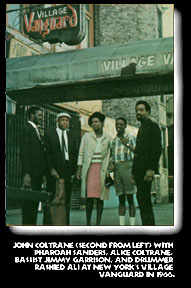


 |
 |
 |
John Coltrane's seminal masterpiece "A Love Supreme" was recorded in late 1964. Invoking the ecstatic spirit of non-Western religious tradition, John Coltrane opened the eyes of the jazz world to a new spiritual potential. Jazz, a music driven by rhythm and extended improvisation, was a medium ideally suited to the exploration of mystical ideas only partially communicable through the spoken word. |
This content was originally created by
Ian Scott Horst.
It has been edited, updated, and organized by freeform. |
The social revolution of the 1960s called into question the whole function of music in a social and cultural framework. The rebellious youth culture sought in music an outlet for expression freed from the rules and boundaries set by previous generations. A newly self-aware African-American community sought in music a reconnection to African roots and heritage, as well as the forging of new cultural identities. And finally, dissatisfied by religious institutions that seemed ossified and abstract, millions undertook a spiritual quest, exploring the ideas of religions and philosophies from around the globe, especially those that offered the intensity of religious ecstasy combined with the tranquility of meditation.

These things combined to help jazz free itself from its strictures as it became a vehicle for exploration and self-expression. Non-European religion (especially Hinduism; West African Yoruba Religion, including its Afro-Cuban and Brazilian variants, Santeria and Candomble; Buddhism; forms of Islam; and charismatic forms of African-American Christianity) long recognized in music a potential for the ecstatic spiritual experience. Music could be a vehicle for a moment of transcendance allowing an epiphaniacal understanding, or an entrancing rhythm that could suspend the normal perceptions of time and space. It could be the opportunity for intense communion with God and the divine and it could even be the trigger for spirit possession.
This was a kind of homecoming for jazz: the music that had been created in New Orleans' Congo Square, site of "voodoo" ceremonies during slavery times. Jazz was one of the secular repositories of memory of African tradition, and now its sacred spirit could be reclaimed.
As the jazz musicians of the late 1960s encountered and adopted aspects of these spiritual philosophies they began to reshape their music forms and ideas. Sometimes this meant the music reflected the devotions of its creators, but sometimes this meant the music took on the forms and excitement of something meant to provoke a response across boundaries of intellect, aesthetic, and emotion. Some called it free, some called it angry. Of course not every experimental musician of the 1960s had spirituality as the driving force behind their creativity, but many did.
 |
A Jazz Supreme |  |